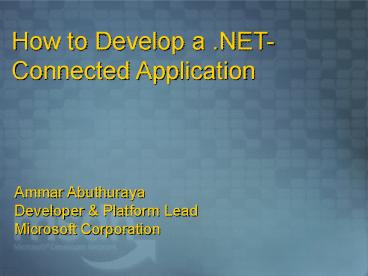How to Develop an EndtoEnd 'NETConnected Application with Microsoft 'NET - PowerPoint PPT Presentation
1 / 29
Title:
How to Develop an EndtoEnd 'NETConnected Application with Microsoft 'NET
Description:
Browsers. Smarter. Clients. Smarter. Devices. Open Internet ... Attributes define behaviour. Dynamic and Manual Registration. Serviced Components - cont ... – PowerPoint PPT presentation
Number of Views:45
Avg rating:3.0/5.0
Title: How to Develop an EndtoEnd 'NETConnected Application with Microsoft 'NET
1
How to Develop a .NET-Connected Application
Ammar Abuthuraya Developer Platform
Lead Microsoft Corporation
2
Session Prerequisites
- This session assumes you have
- Basic knowledge of any Windows DNA languages
(e.g. VB6) - Familiarity with ASP
- Conceptual knowledge of Microsoft BizTalk Server
- Familiarity with SQL Server
Level 300
3
What We Will Cover
- How to develop .NET applications
- How to develop the business tier
- How to manually invoke Web services
- How to integrate BizTalk and .NET with COM
interop - How to deploy a Web project with Microsoft
Visual Studio
4
Agenda
- .NET application overview
- Microsoft ASP.NET vs. ASP classic
- Designing business layer
- COM, ADO.NET and SQL Server
- Deploying Web applications
5
.NET Application Overview Introduction to .NET
Applications Become Programmable Web Services
Standard Browsers
Open Internet Communications Protocols (HTTP,
SMTP, XML, SOAP)
Richer, MoreProductive User Experience
Applications LeverageGlobally-AvailableFederated
Web Services
6
.NET Application Overview Introduction to .NET
Applications Become Programmable Web Services
Standard Browsers
Open Internet Communications Protocols (HTTP,
SMTP, XML, SOAP)
Richer, MoreProductive User Experience
Applications LeverageGlobally-AvailableFederated
Web Services
7
.NET Application Overview.NET Platform Roadmap
Internet Protocols SOAP, HTTP, SMTP, XML
8
.NET Application Overview Sample Application
- Integrates a product distributor and its remote
warehouse - No native Internet support
- Large amounts of data
- Potentially large network latencies
9
.NET Application Overview Sample Application
Layers
- Logical 3-tier design
- Presentation tier (ASP.NET)
- Business classes (Visual Basic .NET)
- Serviced Component, Data Access layer (C)
- Functional requirements
- Cache data on the Web server
- Use XML over HTTP to communicate with warehouse
10
Demonstration 1Application Overview Running
the Product Inventory Application
11
Agenda
- .NET application overview
- ASP.NET vs. ASP classic
- Designing business layer
- COM, ADO.NET and SQL Server
- Deploying Web applications
12
ASP.NET vs. ASP Classic ASP.NET Architecture
Improvements
- Compiled code
- Page and data caching
- Post-back forms and ViewState
- Server controls
- Session state
13
ASP.NET vs. ASP Classic ASP.NET Architecture
Improvements
- Compiled code
- Page and data caching
- Post-back forms and ViewState
- Server controls
- Session state
14
ASP.NET vs. ASP Classic ASP.NET Programming
Changes
- Supports any .NET language
- Separation of HTML and code
- Any element is scriptable
15
Demonstration 2ASP.NET CachingCaching In The
Presentation Layer
16
Agenda
- .NET application overview
- ASP.NET vs. ASP classic
- Designing business layer
- COM, ADO.NET and SQL Server
- Deploying Web applications
17
Designing a Business LayerThe .NET Way
Website
PresentationAssemblies
GACUTIL.EXE
18
Designing a Business LayerThe .NET Way
Website
PresentationAssemblies
GACUTIL.EXE
19
Designing a Business LayerLocating a Dependency
- Strong names
- SN.EXE
- Dependency resolution
- Search local directory
- Search GAC
20
Demonstration 3XML, HTTP, and Typed
DatasetsManually invoking a Web
serviceCreating a typed DataSet
21
Agenda
- .NET application overview
- ASP.NET vs. ASP classic
- Designing business Layer
- COM, ADO.NET and SQL Server
- Deploying Web applications
22
Components And ServicesServiced Components
- The Easy Way to Build COM Applications
- Support is Integral to .NET
- System.EnterpriseServices
- ServicedComponent Class
- Attributes define behaviour
- Dynamic and Manual Registration
23
Serviced Components - cont
- Component Services
- COM Base Services supply application host
(server) - Provides context, security, transactions,
pooling, loosely-coupled events, asynchronous
activation - Integrated into Operating System highly tuned
24
Accessing DataADO.NET
25
Accessing DataDisconnected Data
Data Tier
Business Tier
Presentation Tier
26
Sample Application Detail
SQL Server
Application
Channel
27
Sample Application Detail. cont.
ADO.NET
Enterprise Services
SQL Server Database
XML DataSet DataAdapter Connection
CLR
28
Demonstration 4COM, ADO.NET and SQL
ServerUsing the ADO.NETServiced Componentto
Pass Data into SQL Server
29
Agenda
- .NET application overview
- ASP.NET vs. ASP classic
- Designing business layer
- BizTalk Server and COM interop
- Deploying Web applications
30
Deploying Web Applications
- Deployment
- Copy Project
- Xcopy
- setup projects
- Maintaining your application is simple
31
Deploying Web Applications Notes
- Deployment
- Copy Project
- Xcopy
- Setup projects
- Maintaining your application is simple
32
Deploying Web Applications Notes
- Deployment
- Copy Project
- Xcopy
- Setup projects
- Maintaining your application is simple
33
Session Summary
- .NET application overview
- ASP.NET vs. ASP classic
- Designing business layer
- COM
- ADO.NET
- SQL Server
- Deploying Web applications
34
(No Transcript)































